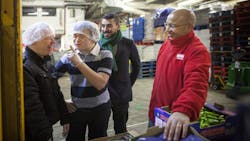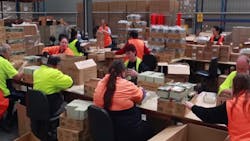Not Employing the “Differently Abled” is a Huge Disability
As we’ve reported over the years, hiring people with disabilities for warehousing work is one of the best decisions employers can make. Randy Lewis, who was senior V.P. of distribution and logistics for Walgreens before retiring a couple years ago, now spends his time spreading that message from community to community whenever he can. His story started at Walgreens’ Anderson, South Carolina distribution center, where about 40% of the employees are “differently abled,” as he puts it. It turned out to be one of the chain’s most productive facilities because the work of those “special” employees raised everyone’s game and the word “special” is now applied to what happened at that site.
This story came up during MH&L’s recent editorial advisory board roundtable in the context of the logistics talent challenge. The question arose, “why are employers having such a hard time attracting people to work in their logistics operations? Jim Shephard, president of Shephard’s Industrial Training Systems, said it’s because many people who have worked in this space have disabled themselves as viable candidates.
“Right now there is a real abundance of talented people in the unemployment ranks, and I don't know how to get them off of it,” Shephard said. “A lot of them have specific skill sets, and they are not willing to learn new skills. They say, ‘well, I am waiting.’”
These are people who’ve become disabled by job hopping. Shephard says this is especially challenging in regions with a lot of seasonal workers. During peaks these companies may fill their warehouse with hundreds employees. When that season is over, those people hit the street to look for work again. This teaches these workers bad habits, and it hurts employers by giving them a disability: talent blindness. They end up not differentiating the talent from the pool.
“In Memphis, we see a 25 percent shift in the work force annually,” Shephard added.
This doesn’t give employers or fellow employees a chance to enjoy the team dynamic that Walgreens enjoys. One of the other participants in our roundtable was a second-time attendee: Ron Zybura. He’s a consultant in career and technical education with Ohio’s Cuyahoga County State Support Team 3. In his work with special needs clients, he has witnessed the kind of job loyalty and talent the employers I just described are deprived of.
“Generally people with special needs live in the here and now, and they enjoy work,” Zybura said. “That spreads to the people they work with. But it starts with training partnerships, with career centers that will involve a group of students and rotate them through a set of jobs. The jobs can change, but if you do branch changing—if this doesn't work, go to this—once the job is learned you wouldn't have that 25 percent attrition Jim mentioned.”
“Generally people with special needs live in the here and now, and they enjoy work. That spreads to the people they work with."—Ron Zybura, consultant in career and technical education with Ohio’s Cuyahoga County State Support Team 3Zybura explained that trainees with autism, for example, are often skilled in focusing on details and following procedures.
“You can work with career centers and career technical planning districts to provide onsite training,” he explained. “The teacher will bring a group of students, they will go through a set of processes, and you can find a match between student skills and job expectations—then hire from that group of interns.”
Walgreens adopted this kind of model in its partnership with Have Dreams, an advocacy group for children with autism. They took it a step further, however. They developed a training facility in Evanston, Ill, as part of its expanded commitment to have employees with disabilities make up 10 percent of its distribution center workforce.
Procter & Gamble followed Walgreens’ example and announced their intention to have at least 30 percent of employees at a new packaging facility in Maine be people with physical or developmental disabilities.
That trend is gradually growing. On May 1st, German software company SAP announced it will be hiring five new team members on the autism spectrum at its headquarters in the Newtown Square Office. The announcement came out of the company’s Autism at Work Initiative that began last year with the goal to train and employ more than 600 people on the autism spectrum worldwide by 2020.
This is smart thinking, and the material handling industry is all over it. In its Material Handling & Logistics Roadmap strategizing what the industry must accomplish by 2025, MHI says this:
“By 2025, there should be a significantly different profile of the typical employee in material handling and logistics. Four groups in particular—women, workers under 35, people with disabilities, and veterans—should especially be targeted by the recruitment and career path development programs. There should be a special focus on mentoring and promoting these individuals.”
This is smart because not only does it help people with disabilities stay working, but it ensures their employers will share that ability.
(Go to our gallery of leaders finding an ROI in untapped talent.)
About the Author
Tom Andel Blog
former Editor-in-Chief
As editor-in-chief from 2010-2014, Tom Andel oversaw the strategic development of MH&L and MHLnews.com, bringing 30+ years of thought leadership and award winning coverage of supply chain, manufacturing logistics and material handling. Throughout his career he also served in various editorial capacities at other industry titles, including Transportation & Distribution, Material Handling Engineering, Material Handling Management (predecessors to MH&L), as well as Logistics Management and Modern Materials Handling. Andel is a three-time finalist in the Jesse H. Neal Business Journalism Awards, the most respected editorial award in B2B trade publishing, and a graduate of Cleveland’s Case Western Reserve University.

